Dismantling: Old music center
 It's amazing how preferences change over time. 15 years ago I wanted to buy a music center more than a new computer. I didn’t even guess that a set of individual components is much better. Not! It was dreamed about the combine, with numerous light bulbs and baubles, and that it was possible to rewrite CDs on the tape. The fashion for such units gradually faded away, home theaters replaced the coarse beauties, and in general it became somehow easier with audio playback devices. Or is there more money? In any case, the purchase of an audio system is no longer a landmark event. Well bought and bought, which is already there.
It's amazing how preferences change over time. 15 years ago I wanted to buy a music center more than a new computer. I didn’t even guess that a set of individual components is much better. Not! It was dreamed about the combine, with numerous light bulbs and baubles, and that it was possible to rewrite CDs on the tape. The fashion for such units gradually faded away, home theaters replaced the coarse beauties, and in general it became somehow easier with audio playback devices. Or is there more money? In any case, the purchase of an audio system is no longer a landmark event. Well bought and bought, which is already there.And yet, when I was visiting friends, I saw the old Sony music center, I could not just pass by. The unit that exchanged the second decade was the very dream of my youth. It turned out that the piece of iron has been idle for several years now, since when turned on it produces a terrible rattle. I must say that I like to disassemble the glands even more than using them. Therefore, having received good from the owners, he took up the screwdriver, setting himself the maximum task - to repair, the minimum task - to see how it worked and send the old man to the dump with honor.
UPD. Transferred to the "Old Iron". At least another pair of old devices are ready to become a victim of a screwdriver :)
')
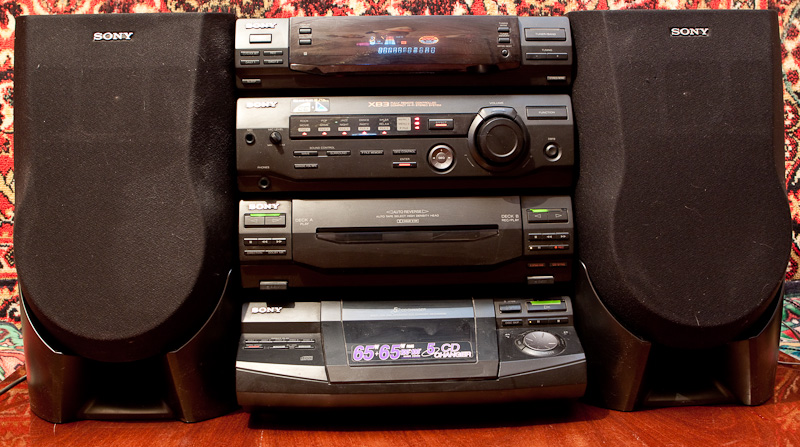
Before the start of the showdown - a photo for memory, but it is not known how it will go further. The Sony HCD-XB3 music center is presented on the authentic background of its racket. Surprisingly, this device is so outdated in just a dozen years. Cassettes - of course, the last century, but the CDs have already ceased to be relevant. Than to charge the carousel on this unit on 5 CDs, it is easier to connect a laptop or MP3 player to the line input. A service guide for this miracle with detailed disassembly instructions was found on an extremely useful website dedicated to the technology and its repair monitor.net.ru . Did I study it before starting repairs? No, because it would be too boring! But in a couple of difficult moments the instruction helped me a lot.
Characteristics of the apparatus are as follows:
Output power 2x65 Watts RMS
Two cassette decks with automatic reverse and electronic control, frequency range 60-13000 Hz for standard tape Type I
CD changer for five disks , frequency range 2-20000 Hz, signal / noise ratio> 90 dB
Radio FM / VHF (65-74, 87.5-108 MHz), LW (153-279 kHz), CB (531-1602 kHz)
Microphone jack and karaoke function
Line input and input for the turntable, there is a built-in phono stage (thanks to standov )
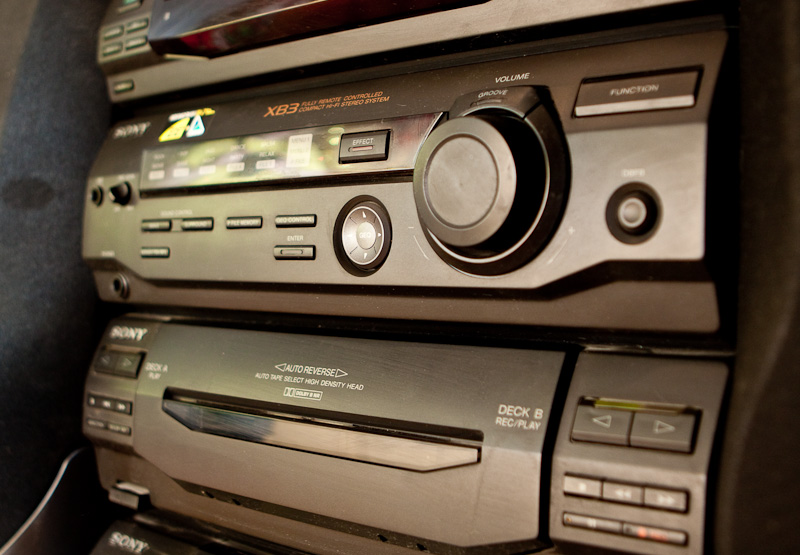
In the 90s, the manufacturers of various equipment (not only music centers) had one major change: instead of developing devices qualitatively, they were hung with simple “marketing” features, actively advertising them. The hardware part at the same time has ceased to differ even from different manufacturers. As it becomes clear from the service manual, the cassette deck, CD player and amplifier of this model are up to the last screw of almost a dozen similar music centers. In the Sony XB3 such low-use appendages are also complete. Various preset equalizers, a separate bass boost system and a large “Groove” button that makes the sound even more wooden, karaoke and a pair of DJ lotions, such as the ability to loop a certain piece of a song right during playback.
Another fashionable feature of the music center is a solid lid that covers two tape decks at once. The solution is unusual, but convenient because at any time you can, without turning off the playback, open the lid and see how much tape is left to the end.

To stick a huge blyamba with an indication of power - this is sacred! At least it's good that watts are not Chinese (they make 1000W).

I start disassembling. The top and side covers are combined into one element, so it didn't take long. From the photo you can estimate how much dust has accumulated inside over many years. Inside the music center is presented in the form of several boards. The panel in the photo on the right is responsible for control and the LCD display (UPD. Never LCD! As standov says, it is a vacuum luminescent) . In the background, there is a board with a preamplifier, a cassette deck and a CD player are connected to it. A separate module with two line inputs is attached to the board. Below, a power amplifier is bolted to a large radiator, and in the foreground you can see the power supply.

Close-up Dolby B noise filter, Hitachi production chip.
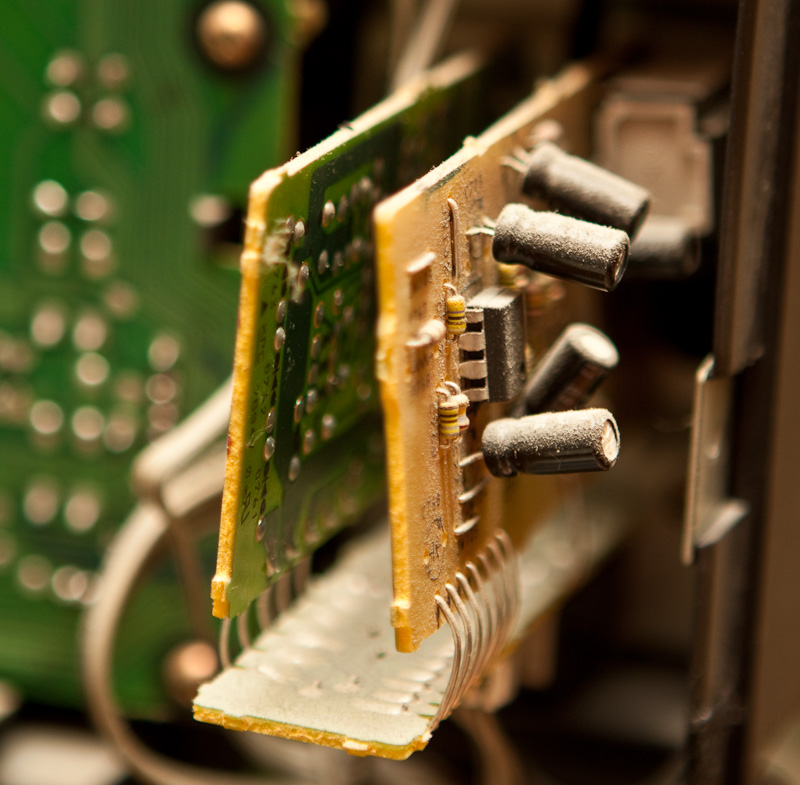
An unusual looking karaoke system board (on the other hand, a microphone jack and level control).

Chip with Sony logo, although the number on the Internet is an 8-bit microcontroller manufactured by Toshiba.

The most interesting part of the music center is the power amplifier, based on the Sanyo STK4172II element. Judging by the datasheet , the amplifier provides an output power in the range of 6-50 watts.
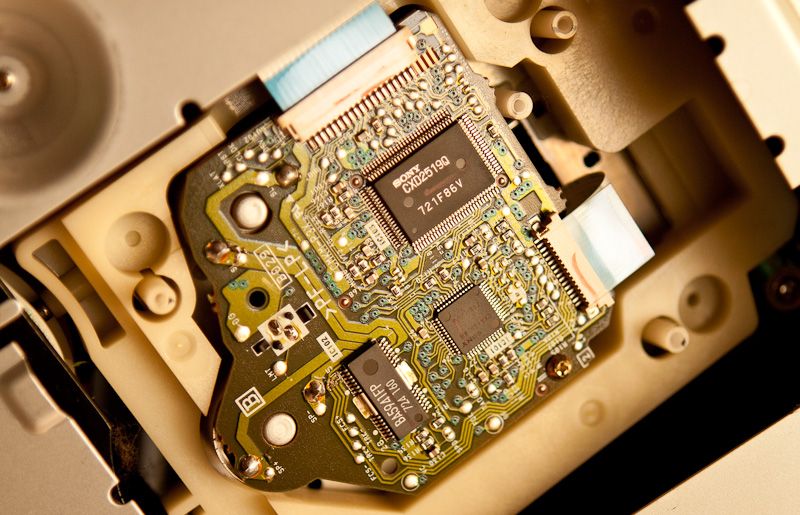
Unusual card controlling a CD player. It is hidden under a special hatch on the bottom of the music center. Chip CXD2519Q - digital signal processor.

Disassemble the stereo completely turned out to be quite simple. It is only necessary to disable several flexible cables (they are all different sizes - you will not mix it up) and unscrew a dozen screws. It looks like the "carousel" - a separate module of the CD-changer.
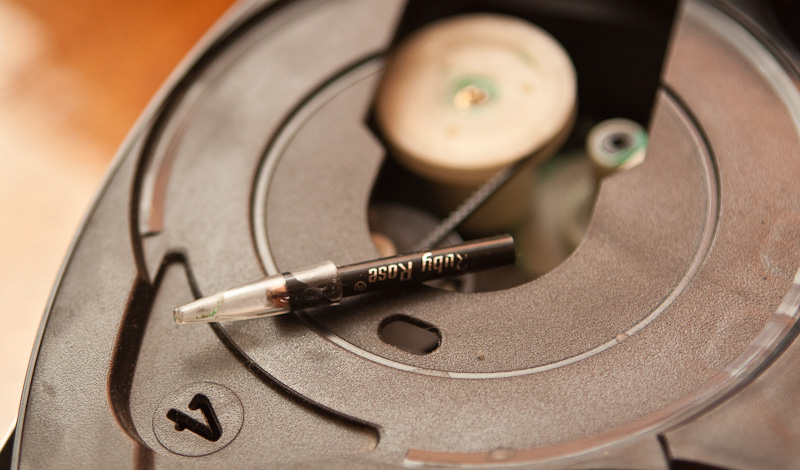
The first (but not the only, as it turned out later) cause of the terrible sounds that the center made when turned on was immediately discovered. Small pencil stuck between the gears, rotating the disk changer.
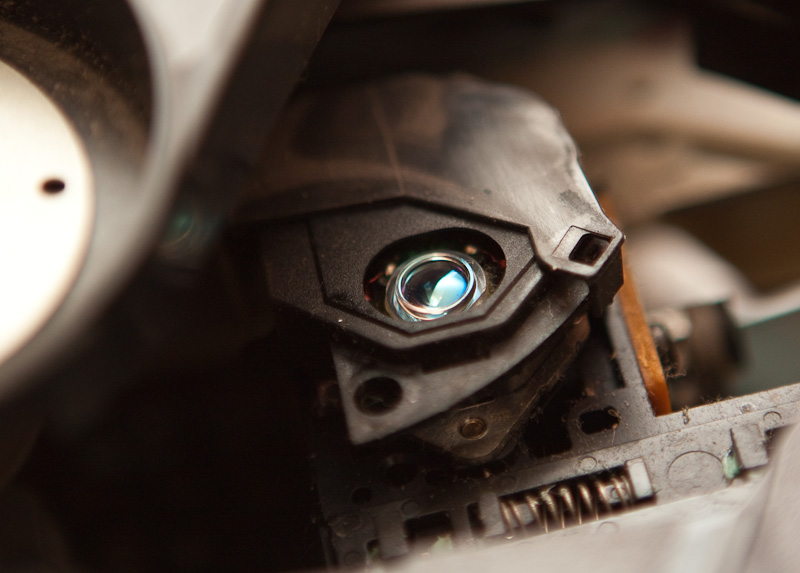
Lens in the read head of a CD player. Just in case, rubbed.
I immediately, putting everything together on a live thread, tried to play a CD (which, by the way, also lay in the music center for at least three years). Happened! The joy was somewhat overshadowed by the fact that the gnash did not completely disappear, and now it was heard only from the cassette deck.
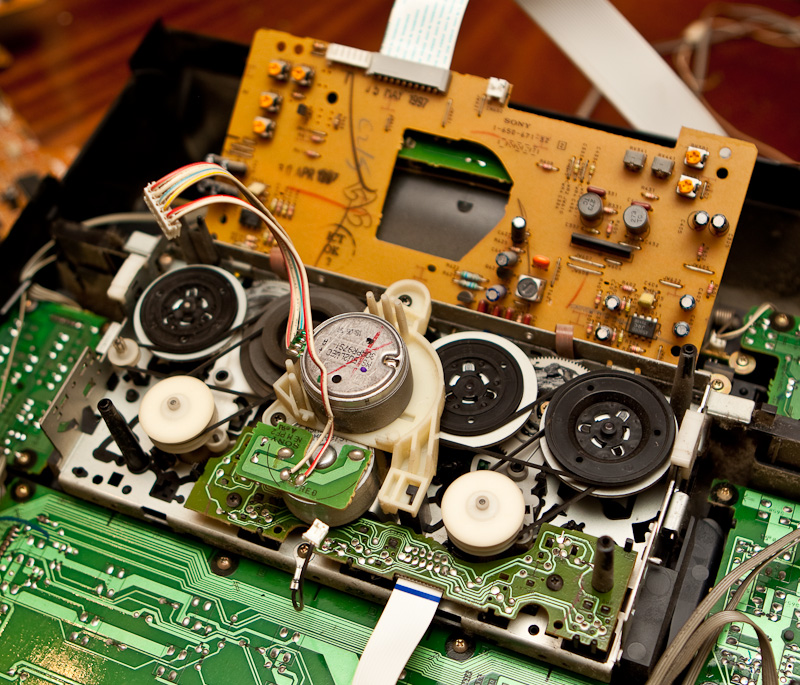
Removing the cassette module turned out to be the only task for which I had to read the service manual - otherwise I would definitely have broken something. In the photo - a cassette deck with a removed board, to which leads from magnetic heads lead. Not the highest quality design: both decks are controlled by a single motor (in the center). Another auxiliary motor is responsible for the automatic reverse, and in it, as it turned out, the problem lay.
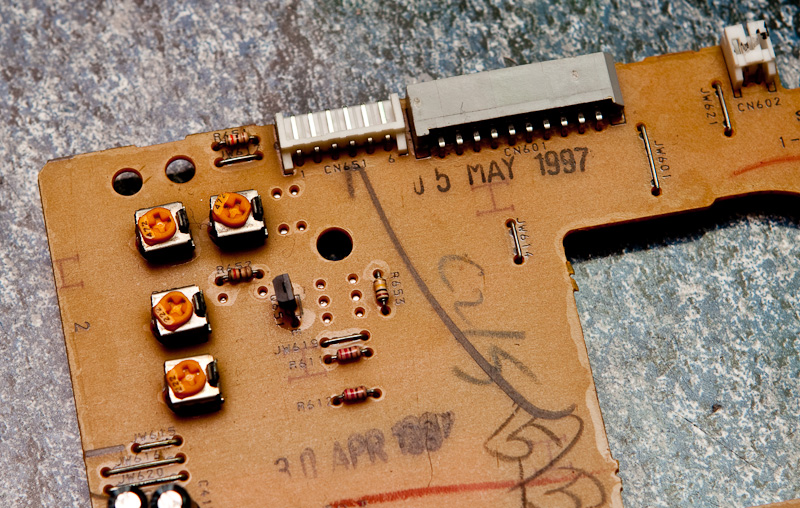
Thanks to a stamp on the control board of a cassette deck, it was possible to determine the year of release of the music center - 1997. 12 years old, the same age as my old IBM ThinkPad .

Magnetic head with a swivel mechanism and rollers. Around dust, dirt and rust. For about two hours I tried to set up a slipping mechanism. As it turned out, the automatic reverse caused all the problems. Apparently, due to the loosely fitting “fashionable” cassette deck cover, a huge amount of dust accumulated inside. The mechanism of turning the head and its “approach” to the magnetic tape was gradually clogged up, and it was becoming more and more difficult to turn it with the help of plastic gears. As a result, the smallest gear on the auxiliary engine (it just starts the auto reverse mechanism) cracked and flew off the mount. I put the gear back in place and, manually rotating the mechanism, “developed” it. But this is clearly not for long: sooner or later, the gear will fly off again, and the cassette deck will not work. Considering how often I listen to tapes (it happens once a year), this is not the biggest loss.
Reverse assembly of the music center did not take much time and, surprisingly, there was not a single extra screw! The audio system no longer produces a terrifying screech, and can perform the honorary duties of an amplifier for a laptop and a radio alarm clock. And I got a lot of pleasure, digging into the dusty mechanics, and imagining how much joy such a piece of iron would give me if it got to me new, in 1997.
Of course, this is not the most remarkable music center. It is not too high quality, there are few really good technical solutions, too many light bulbs and meaningless functions. The columns, though large, are made of thin chipboard, and “buzz” slightly at high volume. Trying to simultaneously pull two rubber belt on one engine, I was thinking about how much easier it was to live with information carriers that lack moving elements. Modern MP3-players are not afraid of dust, they do not need to be cleaned with a cotton swab with alcohol, there is no need to adjust the position of the heads. It seems to me that most of the nostalgia for tapes or vinyl (I'm sick of it too) is because it was not just listening to music, it was a process! And now what, pressed the button and all? Not interested. However, I am still happy with the progress, and for nostalgia I will continue to continue to repair (or break) such old devices.
Source: https://habr.com/ru/post/81093/
All Articles